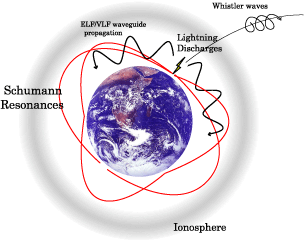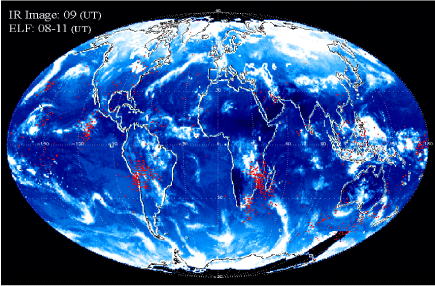
| Lightning discharges between thunder clouds and the ground radiate powerful radio noise bursts over a wide frequency range from a few Hz to higher than several hundreds of Megahertz. Radio noises in the ELF (3 Hz -3 kHz) and VLF (3-30 kHz) range can propagate over long distance through the Earth-ionosphere waveguide [Barr et al., 2000]. Especially, radio noises in the frequency range less than 50 Hz can propagate globally with extremely low (less than 1 dB/Mm) attenuation rates [Jones, 1999]. Interferences of these globally propagating waves result in the Earth-ionosphere cavity resonances known as Schumann resonances (SR) with their fundamental mode at 8 Hz [Burke and Jones, 1996; Sentman, 1996; Huang et al., 1999; Jones, 1999]. The continuous SR background noises of amplitudes of ~1 mV/m or 3 pT are a superposition of individual pulses arriving from random lightning strokes whose occurrence rate is about 100 strokes/sec all over the world [Belyaev et al., 1999]. From these characteristics of SR waves, it is possible to monitor lightning activity in the world even if measurements of the magnetic or electric field of SR waves are carried out at only a single station. |  |
|
Occasionally, transient
oscillations with a dominant frequency of 8 Hz are observed above the
background SR noises. The
amplitudes of these transient SR are a factor of 10 or more greater
than the background noises. It
is suggested that these transients are the Earth-ionosphere cavity
resonances excited by extremely large lightning strokes and could be
observed globally [Sentman, 1989].
Burke and Jones [1996] suggested that the transient
SR waves are likely to be produced by positive cloud-toground (+CG)
discharges characterized as large current moments and slightly longer
continuing currents. Additionally,
recent observations of SR by Boccippio et al. [1995] and Füllekrug
and Reising [1998] revealed that many of these transient SR waves
are associated with transient luminous events in the mesosphere called
gspritesh. They suggested
that particularly large +CG discharges would excite both the
Earth-ionosphere cavity resonances and the sprites simultaneously. Huang et al. [1999]
developed a technique to estimate the charge moments of lightning
discharges associated with sprites from ELF data. They showed that the derived
charge moments Qdl of 200-2000 C-km are sufficient to trigger
conventional breakdown at sprite altitudes of ~50-70 km.
|
| Using these transient SR waves observed at multi observation point, it is possible to geo-locate CG location exciting these transients. Right figure shows the global IR cloud image and estimated CG location [Sato et al., 2002; Sato et al., 2003]. In this figure regions of high cloud top altitude are indicated white color, and red dots correspond to the estimated CG location. CG locations are estimated by using ELF data obtained at Syowa station in Antarctica and Onagawa observatory in Japan. At high cloud top regions strong upward convections are developed. That is enough to create strong thundercloud and intense lightning discharges. Continuous measurement of SR waves is the best way to monitor global lightning activities. |
 |
|
It is
also possible to estimate global occurrence regions and rates of
sprites. First, intense transient SR waves are selected from ELF
waveform data. Then, charge moments of CG discharges inducing these
waves are estimated by using equations of normal mode expansion for SR
waves. From the results by Hu et al. [2002], sprite
initiation probabilities of these CG discharges can be
calculated. Finally, the occurrence rates and locations are
derived.
Right figure shows a averaged diurnal sprite
occurrence rate in the summer season of northern hemisphere [Sato et
al., 2002]. It is found that the global occurrence rate of
sprites is estimated to be about 720 events/day on average. It is also found that the active regions of
sprite occurrences are located in North and South America, Africa and
South-East Asia. |
|
Barr, R., D. Llanwyn Jones, and C.J. Rodger, ELF and VLF radio waves, J. Atmos. Solar-Terr. Phys., 62, 1689, 2000. Belyaev, G.G., A.Yu Schekotov, A.V. Shvets, and A.P. Nickokaenko, Schumann resonances observed using Poynting vector spectra, J. Atmos. Solar-Terr. Phys., 61, 751, 1999. Boccippio, D.J., E.R. Williams, S.J. Heckman, W.A. Lyons, I.T. Baker, and R. Boldi, Sprites, ELF transients and positive ground strokes, Science, 269, 1088, 1995. Burke, C.P., and D.L. Jones, On the polarity and continuing currents in unusually large lightning flashes deduced from ELF events, J. Atmos. Terr. Phys., 58, 531, 1996. Füllekrug, M., and S.C. Reising, Excitation of Earth-ionosphere cavity resonances by sprite-associated lightning flashes, Geophys. Res. Lett., 22, 4145, 1998. Huang, E., E. Williams, R. Boldi, S. Heckman, W. Lyons, M. Taylor, T. Nelson, and C. Wong, Criteria for sprites and elves based on Schumann resonance observations, J. Geophys. Res., 104, 16943, 1999. Jones, D.L., ELF sferics and lightning effects on the middle and upper atmosphere, Modern Radio Science 1999, pp. 171, 1999. M. Sato, H. Fukunishi, Y. Takahashi, T. Adachi, A. Okubo, and W.A. Lyons: Charge moment differences in winter of Japan and summer of the United States, EOS Trans. AGU, 83(47), Fall Meet. Suppl., F136, 2002. M. Sato, H. Fukunishi, M. Kikuchi, H. Yamagishi, and W.A. Lyons, Validation of sprite-inducing cloud-to-ground lightning based on ELF observations at Syowa station in Antarctica, Journal of Atmospheric Solar-Terrestrial Physics, 65, 607-614, 2003. Sentman, D.D., Schumann resonance spectra in a two-scale-height Earth-ionosphere cavity, J. Geophys. Res., 101, 9479, 1996. Sentman, D.D., Detection of elliptical polarization and mode splitting in discrete Schumann resonance excitation, J. Atmos. Terr. Res., 51, 507, 1989. |